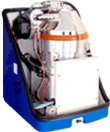WhisperGen™: Domestic Cogeneration Appliance

 Not exactly carbon free but certainly doing lots more with less.
Not exactly carbon free but certainly doing lots more with less.The engineering of this sleek home appliance combines a stirling engine with a patented 'woble yoke' transmission technology. The yoke converts the linear motion of the engine's four pistons into rotary motion able to drive an alternator.
The result is a domestic cogen boiler unit that produces hot water for space heating, showers and electicity to feed back to the grid ( AC models) or to charge batteries in off grid applications ( DC models).
The product is currently available in the UK on "advanced trial". The AC system runs on natural gas or LPG only. The DC unit runs on automotive diesal and a kerosene version is available. Potentially the AC unit could run on Biogas and the DC unit could run on Bio Diesal or other natural oils. According to the comapny use of alternative fuels will involve a 2-3 year testing and certification process.
In 2004, Whisper Tech signed an agreement with Powergen, a German-owned electricity distributor which is one of Britain's largest energy companies to supply at least 90,000 of the units over five years.
I have yet to find pricing but I know this is not going to be as cheap as a dishwasher even thought it looks like one. I imagine prices will come down if and when mega mass production gets into full swing. If you think of the cost of a conventional hot water heater / furnace plus the value of instalation and electrical generation your talking mucho dinero.
http://www.whispergen.com/main/applications/





